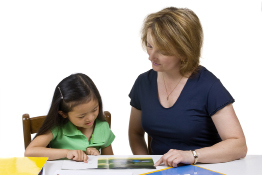Session 1
Completion requirements
Created by IMSreader
1. Session 1
1.3. Page 2
Session 1: Nurturing Through Physical Routines
Responsibilities of the Child Care Provider

© matka_Wariatka/shutterstock
Child care providers need to ensure they carry out the following responsibilities:
- Children are served nutritious food in accordance with Canada’s Food Guide. Check out the nutritious suggestions offered on Canada’s Food Guide website. This site includes all kinds of interesting information and activities for both young and old!
- Foods of questionable proportions and textures are served in appropriate sizes to eliminate the possibility of choking.
- Providers need to wash their own hands and help children make sure their hands are thoroughly washed before preparing, serving, or eating food. All food must be eaten in a clean environment.
- To ensure cleanliness, wash hands for appropriately 60 seconds. Did you know that singing the Happy Birthday song twice takes about 60 seconds?
- Encourage conversation among children (and that includes the child care providers).
- Hold babies under six months old when feeding them a bottle because this develops the infant’s ability to trust and to feel secure.
- Sit at the table with children during meals and snacks.
- Support children’s independence and initiative. For example, encourage children to help themselves from a serving bowl and to put their dirty dishes away.
- Use mealtime as an opportunity for learning appropriate social behaviour. Children learn table manners through watching the caregiver’s behaviour and through gentle encouragement. Be sure to model good manners and encourage children to say “please” and “thank you.”
- Do not use food as a reward or a punishment. Food is a human right—it is completely inappropriate to be used as either a punishment or a reward.
- Encourage children to try new foods but never force them.
- Ensure that children have enough time to finish their meals and that they are eating in the appropriately designated area(s).
- Respect cultural differences relating to food and ensure children’s dietary restrictions are met in respectful ways.
- For tips on encouraging healthy habits, read the information included in “Children’s Healthy Eating.” The document is a valuable tool in understanding how to help children make sound food choices. This document can also be found in the Toolkit.
Nap Time

© Thomas M Perkins/shutterstock
As a child care provider, you should aim to follow these guidelines:
- Establish and follow a routine that supports children moving from eating lunch to toileting to rest time quietly, calmly, and without hurrying.
- Try to find ways to help children feel secure at rest time. For example, spend a few minutes with each child or allow each child to take a favourite sleep toy or blanket to the cot or mat.
- Use a variety of quieting techniques to help children settle. For example, rub children’s backs, sit quietly beside them, or read them a story.
- Recognize children’s need for sleep varies. Centres should allow children who need less sleep to play quietly after a period of rest. For example, they can play with books and puzzles on the cot or in a quiet area away from sleeping children.
- Wake up children gradually and gently. Interesting activities should be available for children as they wake. Recognize that some children take a long time to wake up.
- Infants should be encouraged to sleep as their individual needs dictate. They should always have clean, dry diapers before sleeping.
Developmental Reminders
Follow these developmental reminders:
- Infants can require two to three naps per day starting at four months of age.
- At about ten months, one afternoon nap is often enough.
- All children have different needs in terms of napping. Most children continue to take naps until the age of three, some children still nap until age five, and others stop at age two.
- Toddlers may have difficulty going to sleep if there is too much activity going on around them.
Toileting Practices

© AVAVA/shutterstock
As a child care provider, you should commit to the following:
- Always wash your hands before and after diaper changing, and clean the changing surface after each use. These practices help to stop the spread of contagious diseases.
- Diapers should be changed as soon as possible when they are soiled or wet because doing so prevents diaper rash and also helps children to learn to trust as they come to recognize others will, and do, respond to their needs.
- Begin to toilet train a toddler when the toddler shows that she or he is ready. Toilet learning is more successful when parents and child care providers work together. Remember that all indicators must occur regularly to show a child is developmentally ready for toilet training.
- Remind preschoolers to go to the toilet before sleep, outdoor play, and other times when they will be away from a bathroom.
- Respond to toileting accidents in a sensitive and respectful manner. Accidents are common, especially among younger preschoolers. Encourage good hygiene practices. Even toddlers can begin to practise health-related toileting practices, such as washing their hands and flushing toilets.
- In most child care centres, boys and girls use the bathrooms at the same time. Some children may be uncomfortable with this openness. Respect children’s need for privacy. Children start displaying a need for privacy around the age of four.
Developmental Reminders
Follow these developmental reminders:
- Some babies are very fussy when they are being changed and do not like things pulled over their heads. Other babies may enjoy having their diapers changed and welcome the attention they receive.
- Babies may like to roll, twist and turn, and pull off their socks. They should never be left alone on a changing table.
- Between 12 and 18 months, some toddlers like to stand when being diapered. They become interested in their private parts, and like to “help” getting dressed.
- From 18 months onward, many toddlers want to do things by themselves and get frustrated when they can’t.
- Readiness for toilet training is individual. It should only be attempted when all of the following indicators are happening regularly:
- The toddler is dry for at least two hours at a time.
- The toddler has regular bowel movements.
- The toddler shows signs of knowing when diapers are wet or soiled.
- The toddler shows interest in the toilet.
- The toddler can hold and wait after indicating a need.
- The toddler is not in a highly “no-no” period.
- The toddler can verbally express the need to go to the washroom (e.g., “pee,” “poo”).
- The toddler can take off and put on pants on his or her own.
- Before toileting becomes a routine, young children may go through a period when they are especially interested in the acts of urinating and bowel movements. They like flushing toilets, watching others on the toilet, and talking about toileting.
- Even though sometimes young preschoolers need to go to the bathroom, they do not want to leave their play. If you see them wiggling or straining, remind them to go to the bathroom. It is normal for “accidents” to happen in toddlers and preschoolers, and these incidents should be treated calmly and with respect—avoiding shame at all costs.
 Checking My Understanding
Checking My Understanding
Is It Appropriate Practice?
Indicate whether each of the practices in the Is It Appropriate Practice? activity is appropriate. You will be given immediate feedback as to whether or not your answer is correct.